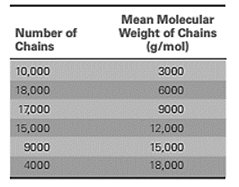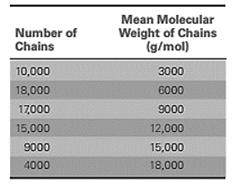
(a)
Interpretation:
The weight average molecular weight and degree of polymerization for the given polymer are to be calculated.
Concept Introduction:
The molecular weight of a polymer is not fixed. It has a certain range under which its molecular weight falls. For a linear polymer, degree of polymerization represents the average length of the polymer. Degree of polymerization is defined as:
Weight average molecular weight
Here,
Answer to Problem 16.15P
The weight average molecular weight for the given polymer is
The degree of polymerization for the given polymer is
Explanation of Solution
Given information:
A sample of polyacrylonitrile was analyzed and the results are:

First calculate the total number of chains as:
Now, calculate the weight for each of the chain category as:
Calculate the total weight of all the chains as:
Calculate the mass fraction for each of the size range as:
Now, use formula (2) to calculate the weight average molecular weight of the polymer sample as:
The repeating unit of the polymer polyacrylonitrile is
Now, use equation (1) and calculate the degree of polymerization as:
(b)
Interpretation:
The number average molecular weight and degree of polymerization for the given polymer are to be calculated.
Concept Introduction:
The molecular weight of a polymer is not fixed. It has a certain range under which its molecular weight falls. For a linear polymer, degree of polymerization represents the average length of the polymer. Degree of polymerization is defined as:
Number average molecular weight
Here,
Answer to Problem 16.15P
The number average molecular weight for the given polymer is
The degree of polymerization for the given polymer is
Explanation of Solution
Given information:
A sample of polyacrylonitrile was analyzed and the results are:

First calculate the total number of chains as:
Calculate the fraction of chain in each of the size range as:
Now, use formula (3) to calculate the number average molecular weight of the polymer sample as:
The repeating unit of the polymer polyacrylonitrile is
Now, use equation (1) and calculate the degree of polymerization as:
Want to see more full solutions like this?
Chapter 16 Solutions
Essentials Of Materials Science And Engineering, Si Edition
- Q2- What are the parameters and loss that can be determined during open-circuit test of singlephase transformer. Draw the circuit diagram of open-circuit test and explain how can you calculate the Parameters and loss.arrow_forwardQ2-Drive the condition of maximum efficiency of single-phase transformer. Q1- A 5 KVA, 500/250 V ,50 Hz, single phase transformer gave the following reading: O.C. Test: 250 V,2 A, 50 W (H.V. side open) S.C. Test: 25 V10 A, 60 W (L.V. side shorted) Determine: i) The efficiency on full load, 0.8 lagging p.f. ii) Draw the equivalent circuit referred to primary and insert all the values it.arrow_forwardQ2- Describe various losses in transformer. Explain how each loss varies with load current, supply voltagearrow_forward
- Below is a projection of the inertia ellipsoid in the b1-b2 plane (b1 and b2 are unit vectors). All points on the ellipsoid surface represent moments of inertia in various directions. Determine I_aa ( moment of inertia) for direction n_a (this is a unit vector).arrow_forwardQ1-A 12 KVA, 440/ 220 V, 50 Hz single phase transformer has 275 secondary turns. The no load current of transformer is 2A at power factor 0.375 when connected to 220 V, 50 Hz supply. The full load copper loss is 198.3 watt. Calculate a) Maximum value of flux in the core. b) Maximum efficiency at 0.8 lagging p.f c) KVA supply at maximum efficiencyarrow_forwardPlease provide the accurate answer to this general accounting problem using valid techniques.arrow_forward
- Q12- A three phase transformer 3300/400 V,has D/Y connected and working on 50Hz. The line current on the primary side is 12A and secondary has a balanced load at 0.8 lagging p.f. Determine the i) Secondary phase voltage ii) Line current iii) Output power Ans. (230.95 V, 99.11 A, 54.94 kW)arrow_forwardQ1- A 5 KVA, 240/120 volt, single-phase transformer supplies rated current to a load at 120 V. Determine the magnitude of the load impedance as seen from the input terminals of the transformer. Ans. 11.52arrow_forwardFor Arduino Timer at 16MHz, if a square wave with frequency 500KHz (50% duty cycle), by choosing the suitable pre-scale make all needed calculations to find the low and high value of Timer-1 bytes.arrow_forward
- Q1- A single phase transformer consumes 2 A on no load at p.f. 0.208 lagging. The turns ratio is 2/1 (step down). If the loads on the secondary is 25 A at a p.f. 0.866 lagging. Find the primary current and power factor.arrow_forwardThe problems are generally based on the following model: A particular spacecraft can be represented as a single axisymmetric rigid body B. Let n₂ be inertially fixed unit vectors; then, 6, are parallel to central, principal axes. To make the mathematics simpler, introduce a frame C where n₂ = ĉ₁ = b; initially. 6₁ Assume a mass distribution such that J =₁₁• B* •b₁ = 450 kg - m² I = b² •Ï¾˜ • b₂ = b¸ •Ï¾* •b¸ = 200 kg - m² K J-I C³ =r₁₁ = r₁₁arrow_forwardThe problems are generally based on the following model: A particular spacecraft can be represented as a single axisymmetric rigid body B. Let n₂ be inertially fixed unit vectors; then, 6, are parallel to central, principal axes. To make the mathematics simpler, introduce a frame C where n₂ = ĉ₁ = b; initially. 6₁ Assume a mass distribution such that J =₁₁• B* •b₁ = 450 kg - m² I = b² •Ï¾˜ • b₂ = b¸ •Ï¾* •b¸ = 200 kg - m² K J-I C³ =r₁₁ = r₁₁arrow_forward
 MATLAB: An Introduction with ApplicationsEngineeringISBN:9781119256830Author:Amos GilatPublisher:John Wiley & Sons Inc
MATLAB: An Introduction with ApplicationsEngineeringISBN:9781119256830Author:Amos GilatPublisher:John Wiley & Sons Inc Essentials Of Materials Science And EngineeringEngineeringISBN:9781337385497Author:WRIGHT, Wendelin J.Publisher:Cengage,
Essentials Of Materials Science And EngineeringEngineeringISBN:9781337385497Author:WRIGHT, Wendelin J.Publisher:Cengage, Industrial Motor ControlEngineeringISBN:9781133691808Author:Stephen HermanPublisher:Cengage Learning
Industrial Motor ControlEngineeringISBN:9781133691808Author:Stephen HermanPublisher:Cengage Learning Basics Of Engineering EconomyEngineeringISBN:9780073376356Author:Leland Blank, Anthony TarquinPublisher:MCGRAW-HILL HIGHER EDUCATION
Basics Of Engineering EconomyEngineeringISBN:9780073376356Author:Leland Blank, Anthony TarquinPublisher:MCGRAW-HILL HIGHER EDUCATION Structural Steel Design (6th Edition)EngineeringISBN:9780134589657Author:Jack C. McCormac, Stephen F. CsernakPublisher:PEARSON
Structural Steel Design (6th Edition)EngineeringISBN:9780134589657Author:Jack C. McCormac, Stephen F. CsernakPublisher:PEARSON Fundamentals of Materials Science and Engineering...EngineeringISBN:9781119175483Author:William D. Callister Jr., David G. RethwischPublisher:WILEY
Fundamentals of Materials Science and Engineering...EngineeringISBN:9781119175483Author:William D. Callister Jr., David G. RethwischPublisher:WILEY





